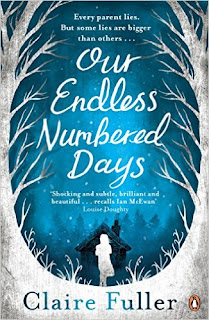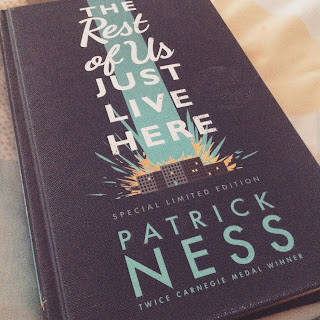Our Endless Numbered Days - Claire Fuller
Highgate, London, November 1985
This morning I found a black and white photograph of my father at the back of the bureau drawer. He didn’t look like a liar. My mother, Ute, had removed the other pictures of him from the albums she kept on the bottom shelf of the bookcase, and shuffled around all the remaining family and baby snapshots to fill the gaps. The frame picture of their wedding, which used to sit on the mantelpiece, had gone too.
On the back of the photograph, Ut had written “James und seine Busenfeunde mit Oliver, 1976” in her steady handwriting. It was the last picture that had been taken of my father. He look shockingly young and healthy, his face as smooth and white as a river pebble. He would have been twenty-six, nine years older than I am today.
Let me preface everything I am about to write by saying that this book filled me with so many emotions. Fuller’s writing style is one that I will continue to return to from now on because this novel has truly just swept me off of my feet and knocked me for six. There is something very fairytale-esque about this novel in it’s setting and the characters, but there is an obvious juxtaposition with the complete sadism with which Fuller treats them.
The novel follows our protagonist Peggy in two different times of her life. When we first meet her she is seventeen and at home in London with her mother and brother, seemingly trying to readjust. We learn this through her reminiscence of when she was 8 years old and spending time with her father. Her father, James, is a survivalist or a “retreater” and is part of a group of men who all believe that the world is going to end and that they need to take precautions. He stockpiles in their cellar and makes sure that Peggy can pack everything she needs, run downstairs and set it all up in the space of little under 10 minutes. When her mother goes to Germany to continue her career as a concert pianist, James decides that Peggy doesn’t need to go to school and they start lessons of survival in their garden; how to make a fire, skin squirrels and what berries and mushrooms were safe to eat. But after an argument with a friend, James decides this is no longer a safe place. He makes Peggy pack her things and they head off to find die Hütte. This is something that Peggy has been told about by her father to be some magical place with a piano and a river with fish you can just lean in and grab, yet it is far less than that. It is ramshackle, dilapidated and nothing that either of them were expecting. They begin to fix it up and it becomes more like home but one morning James comes back and tells her that there is nothing left in the world. There is no one else. Her life is slowly reduced to working to keep them alive, a makeshift piano that makes no noise, and the feeling in the back of her mind that they aren’t alone.
Peggy is an incredible character; mostly because she is flawed. Throughout we see her becoming impatient and as she grows up she tries to become more independent. Her independence isn’t so much of a flaw in itself but it is the fact that she can’t fully destroy the tether linking her to her father. She allows him to instruct her on what to do, which as an eight year old seemed to be a game but at nearly seventeen it becomes more of a challenge. What we see Peggy do is start to challenge her father’s authority and she hides things from him that she otherwise wouldn’t have done. I don’t think she wants to necessarily but she just never finds the right time to tell him.
James’ character is a lot like this through the whole of the novel. He really does believe that this is best for them and frequently becomes angry when things don’t go according to plan. He slowly begins to lose a grip on his sanity throughout and I love the way that Fuller shows this. He becomes obsessive over certain things, even if they’re not likely to work. The first real example of this is the creation of the piano. Even though he can’t make it make a sound he creates a working keyboard out of the wood of their dining room table. Slowly these things get more and more drastic like trying to move the river closer to die Hütte to try and have a closer source of water. Eventually however his real obsession is to change Peggy into his wife, Ute, who he believes to be dead. It’s quite sad to watch his deterioration throughout as we’re never really sure of his next move, especially when he is responsible for looking after Peggy.
One of the strangest things throughout the novel is the idea that they might not be alone. We as readers know that the world has not all gone, because of the changes in time frame, but we do not know if they are alone in this clearing or not. In the corner of the hut behind the stove is written the name Reuben. Peggy starts to feel observed after noticing this name and Reuben becomes more and more of a presence in her life. I don’t want to linger on his character for too long for fear I may spoil the story for some, but his presence is something of a calm away from the storm that is Peggy’s father.
The fairytale aspect of this for me comes in two parts. The first is the setting of this novel. It’s in this clearing in the woods in what I imagine to be like a pretty beaten up shed. The idea of dense forest to hide something or someone away is a pretty big trope in classical fairytales; think of sleeping beauty. Yet I think the biggest link to the fairytale is the fact that Peggy demands that that is not her name to her father and wants to be called ‘Punzel; a shortened form of Rapunzel. Cue thoughts about the Disney film Tangled and Rapunzel being locked away in a tower in the forest.
I think one of the best things that Fuller does is make everything feel incredibly claustrophobic, even though it’s outside. The clearing is never described in terms of its size but it is surrounded by tall trees that you can’t see through, and on three sides there are either mountains or hills. On the fourth side, is the river. After a traumatic experience crossing the river the first time, Peggy states that she will never go near the water again. And she doesn’t. This is really the only way that she can escape from her father, and her fear of it means that she is forced to stay. Even climbing to the highest point on top of the mountain ridge, there is no seeing over the furthest hill and there is no sign of life. The whole setting becomes enclosed and it becomes even smaller still when die Hütte is explored. It’s got a stove and some shelving, a single bed, a table and some stools, and a case with some tools in it. Minimalistic but really all that fits inside. When autumn arrives they even line the walls with logs that they can use for firewood which further brings the walls in and this increases the tension. Peggy’s hide out in the trees even becomes smaller as she grows.
I think that the juxtaposition in time works. We get to see her as a seventeen year old and her as an eight year old both trying to establish themselves in their surroundings. Nothing of what they see is really theres and everything is different to their expectations. I love that there’s this mirrored narrative of really learning more about your surroundings, whilst for Peggy it’s learning about the house and her new brother, but for 'Punzel it’s all about the forest. But this also shows Peggy as flawed without a real knowledge of anything that’s going on around her which really makes you feel for her as a character. I really wanted to just scoop her up and lift her out of the forest to her home in London because the situation does at times become incredibly volatile.
This isn’t a book for the faint of heart. There are times in this where I definitely felt a lot of anger and a lot of sadness but also a lot of anxiety. The setting and the characters altogether really make this such a success. I think that Fuller really captures this imaginative eight year old growing up into a young woman, out of touch with everything she once knew, before being thrown back into society.
Total pages - 382
Total read time - untimed
Rating /10 - 7.5
Recommend - Yes











0 comments :